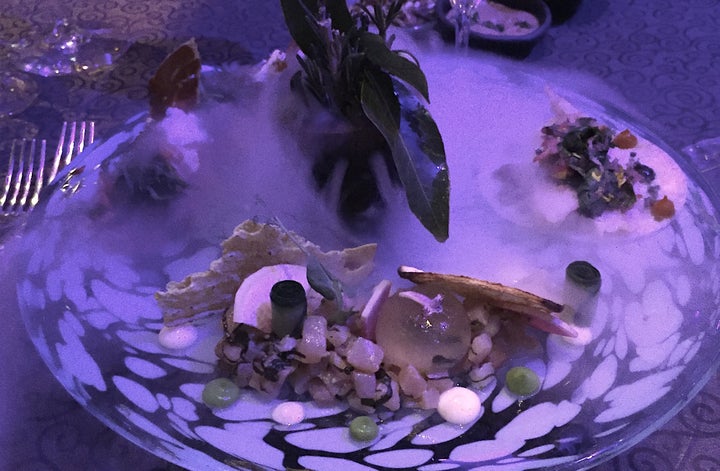
Smoked marlin salad, soft jicama taco with shrimp, marinated watermelon with iberico ham, emerging from dry ice vapor
Over the weekend I had the opportunity to experience Joyà, the Cirque du Soleil show at the Vidanta Riviera Maya resort, in Mexico. Besides being fun and spectacular, the show offers dinner right before the main act, accompanied by music and song. Meshing Mexican flavors with the allure of contemporary fine dining, the menu was well thought out as a component of the evening’s entertainment, from the edible menu printed on thin wafer to the appetizers that came with their own production of dry ice vapor, the “dragon’s breath” amuse bouche that made patrons breathe “smoke” from their mouth and nose, and desserts placed inside a book – books being a central theme of the show. This is the only Cirque du Soleil show so far that integrates food. Besides the whole dinner, guests could choose appetizers and champagne, as creative as the dishes of the main meal.
Although dinner during shows and movies are having a come back, this production showed a different attention to cuisine as spectacle in itself. I could not help thinking that this is far from being a novelty. As a matter of fact, different forms of entertainment accompanied banquets –not everyday meals, mind you - in Western cultures since antiquity. Etruscans and Romans often enjoyed music, dance and poetry while entertaining guest. At the peak the Roman Empire, food itself became part of the spectacle. One of the best representations of these feasts, although probably exaggerated, is Satyricon, a novel by the author Petronius, which describes the outrageous party a freed slave, Trimalchio, throws to flaunt his wealth. In one of the most famous food scenes in world literature - later turned into a visual masterpiece by filmmaker Federico Fellini in his 1969 Satyricon, the extravagance of the dishes includes appetizers in the shape of zodiac signs, live birds lying out of a pie, and a whole roasted pig from which sausages and other pieces of meat fall when cut open.
During the Middle Ages, banquets were still a way to display wealth and power, often accompanied by music. However, over time the ideal of the noble warrior who displayed his physical prowess and affluence through the ingestion of enormous quantities food became outmoded as table manners became markers of social distinction. With the Italian Renaissance, banquets became more complex in terms of dishes, service and vessels involved, reflecting an appetite for spectacle, originality and creativity as an expression of the elites’ desire to showcase their sense of fashion, refinement and elegance. Great families prided themselves in hiring great chefs and, more importantly, famed scalchi, maîtres d’ of sorts, who supervised the cooks and established the choreography of the meal and the composition of the menu with the host.
During the Renaissance, in upper class banquets excitement, entertainment and visual dazzle were as significant as the quality of food and the cooks’ skills. The relevance of these occasions is revealed by their frequent representation in many paintings of the period, as artists focused on an activity that was likely to entice viewers, while paying homage to the wealth and refinement of their patrons. Presentation was paramount: fowls would be served dressed in their own feathers, and rams in their own skins. Grand banquets required specialized servants such as the trinciante, who dramatically carved meats tableside.
In following centuries, banquets upheld Renaissance traditions but revealed less creativity, becoming more complex and overdone while reflecting the prevalent Baroque aesthetics of exaggerated grandeur, exuberance, motion and drama. The feasts thrown by Louis XIV, the King Sun in France, as well as by the nobles who wanted to ingratiate him, were meant to express the absolute power of the monarchy. In May 1664 Versailles turned into a week-long wonderland of parties, food, and spectacles for over 600 guests, with theatrical machineries, actors, and dancers to increase the impact of the meals.
Dinner again became a form of spectacle while claiming to express imaginative sensibilities with the Futurists, a group of artists that in Fascist Italy embraced a very iconoclastic approach conveying a deep fascination with modernity, machinery and speed. In the Futurists banquets, food was meant to glorify the political and colonial future of Italy while criticizing its most backward aspects. The movement manifesto called for the “abolition of the mediocre daily habits in the pleasures of the palate” including the excessive consumption of pasta, condemned as “the absurd Italian gastronomic religion.” Most of the recipes included in the 1932 Futurist Cookbook were far-fetched and unappetizing, as the artists focused more on the performative and spectacular aspects of meals than on flavor.
The Cirque du Soleil Joyà dinner did not have the same pretensions, but harked back to times when food was not just an accompaniment to entertainment, but was integrated in it, taking advantage of all spectacle that can be mustered through ingredients, dishes, and service. This is an approach that, after all, plays an important role in molecular gastronomy and those styles of cuisine that aim at surprising eaters, pushing them out of their comfort zone and making them think about their relationship to food.
